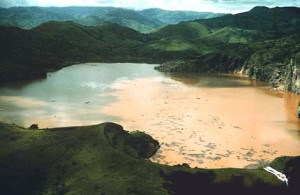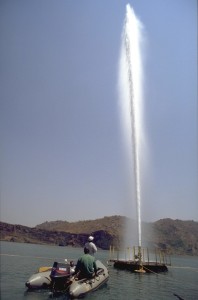On August 26th, 1989, Cameroon’s remote village of Nyos witnessed a strange scientific occurrence in lake water history.

A volcanic mountain cracked and sunk into Lake Nyos, causing a volcanic eruption that left over 2,000 people and animals dead in one night, leaving West Africa with the worst natural disaster of all times.
The Five for National Geographic Channel reported that the tragedy was a complete mystery as victims both young and old collapsed dead besides the many unconscious survivors that badly needed medical attention. The dead were swollen with rashes and burns all over their bodies.
On that fateful day, as the residents were getting set for sleep, a heavy down pour weakened the already fragile rock walls over the lake, forcing it to give way, killing people who were 25KM away from Lake Nyos. A survivor recounted how they heard big rocks falling into the lake area.
Gilbert Kihmah, a survivor described the atmosphere before the disaster as a mixture of gun powder and rotten eggs. But as dawn approached, the smell had escaped into the atmosphere. Kihmah recalls that there was overwhelming shock and anxiety in the air.
As the news spread, the whole nation began counting its dead and Africa faced a difficult crisis in modern day Lake history. Survivors like Fr. Antony Bangsi were weak and unconscious with an urgent need for medical attention. “In our unconscious state, death was unavoidable,” Bangsi said.
As the village of Nyos witnessed the death of 600 people in addition to more 500 deaths in the villages of Soa Mbum, Fonfuka and Buabua , this lake that provided a lifeline to these communities had become their worst enemy.

Unanswered Questions
This disaster has since left many unanswered questions about what could have led to this tragedy.
Scientific researchers, lake experts and volcanologists reasoned that although crater lakes near the equator like Nyos do not have seasonal and temperature changes, lake water circulates releasing carbon dioxide to the atmosphere at a faster rate as the world temperatures change.
Prof Haraldur Sigurdsson, a volcanologist at the Rhodes Island University in South Africa, said that these volcanic lakes are too deep and are sheltered by high imposing rocks. Therefore, water at the bottom of the lake hardly mixes with water at its surface. “Any carbon dioxide that accumulates at the bottom is trapped there”.
He adds that any massive rock falls into the lake triggers the carbon dioxide saturated water beneath to overturn. This, according to him, was what happened on that day.
Prof George Kling, a lake expert at the University of Michigan in USA, confirmed Sigurdsson’s theory and concluded that a dead densely cloud of carbon dioxide had spread over the lake.
Controversy Still Prevails
Today, controversy still prevails between Scientists, Lake Experts and Volcanologists whether such carbon dioxide in the lake could have been able to cause such unbelievable death and destruction.
The Cameroonian government took advice and installed self-powered vent tubes to prevent another deadly buildup of carbon dioxide at the bottom of the lake. An automatic alarm system was also installed at the lake’s gateway to alert residents of any potential dangers.
Impending Danger
Recently volcano logical research has being blowing a new alarm on a looming disaster over the Lake Nyos.
In 2005, the UN office for the Coordination of Humanitarian Affairs, and the United Nations Environment Program UNEP issued a joint report warning that the lake wall had seriously sagged and could crumble within a decade. The report recommended that the walls of the lake be solicited with concrete or some of the lake waters be released to ease the pressure on it.
An official with Cameroon’s Institute of Mining and Geological research which monitors the Lake has however refuted allegations of any dangers around this Lake. “But our government has the project under consideration, but it’s not a priority issue,” he said on conditions of anonymity because he lacked authority to speak for or behalf of the Cameroon government.
If the lake wall collapses again it could kill far more people than the incident of August 1986 according to the Five for National Geographic TV channel. Carbon dioxide might travel as far as 50km to the Cameroon boarders with Nigeria. “The dead toll could be much more devastating and alarming,” the channel reported.
Engineers think that it’s no longer the Questions as to whether the worse will happen by the question is when that will be.
By Aaron Kaah Yancho
